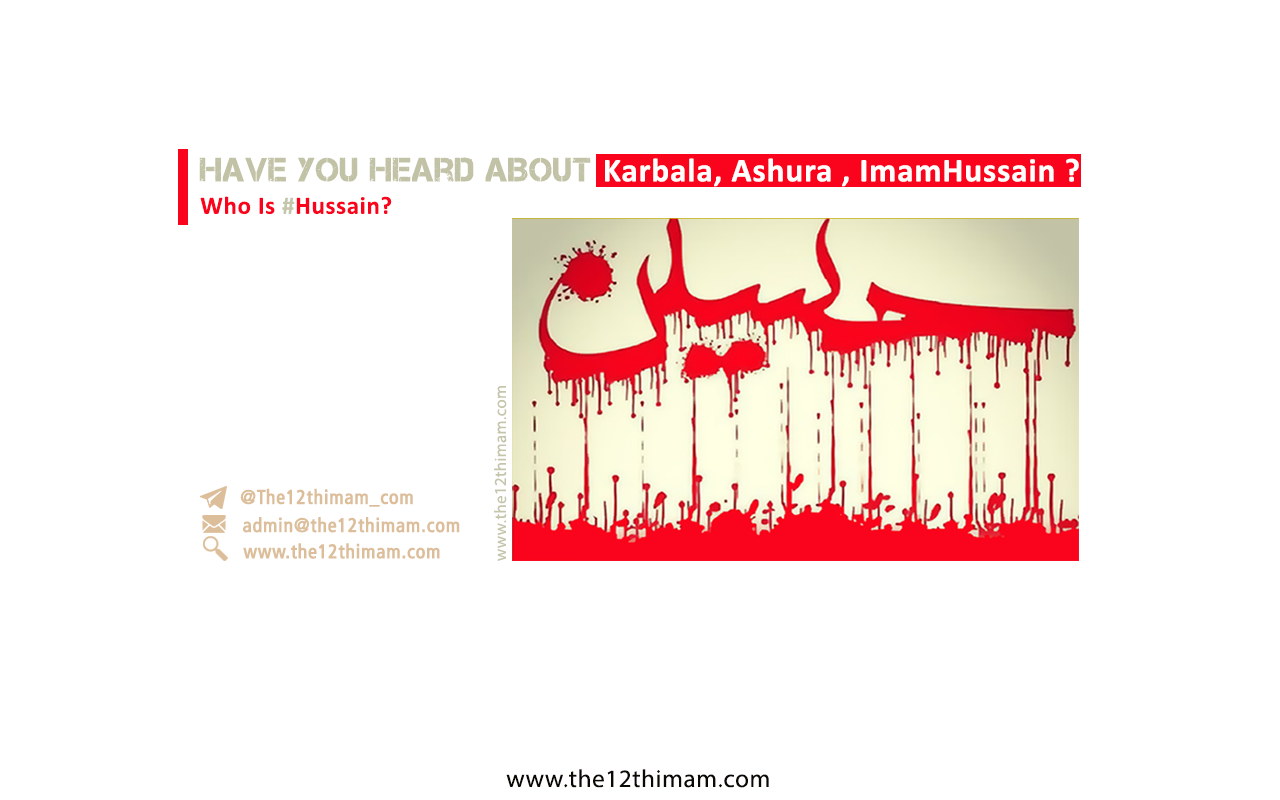Imam #Hussain was one of #prophet Muhammad’s grandsons. His differentiating factor was that he didn’t accept oppression.
He didn’t oppress anyone and didn’t remain silent in the face of oppression. Due to his noncompliance with the tyrant at the time (Yazid) [1] , orders to kill him were issued! #Yazid was a #dictator, a scoundrel, a drunkard, cruel, murderous, and hypocritical. Imam Hussain refused to accept the rule of such a person, so he and his family, along with seventy of his loyal followers, resisted and fought against the thirty thousand men of Yazid’s army. He said such death would be honorable; and obedience to Yazid would be humiliating and degrading. His famous slogan was:
“Death with #dignity is better than #life with humiliation” Eventually, he and his loyal companions were killed by the armies of Yazid in Karbala.
The Battle of Karbala or Battle of ‘Ashura

The Battle of Karbala or Battle of ‘Ashura in which Imam al-Hussain’s (a) fought against an army from Kufa on Muharram 10, 61/October 13, 680 who were mercenary soldiers of Yazid b. Mu’awiya [2] , the second Umayyad caliph. The Battle of Karbala is the most sorrowful incident in the history of Islam, especially for the Shiites. hence they hold huge mourning ceremonies every year during the first (10) days of Muharram.
The movement of Imam al-Hussain (a) began from Medina towards Mecca after the death of Mu’awiya on the first days of Rajab 60/679; and it was the first action of Imam al-Hussain (a) to refrain from giving allegiance to Yazid b. Mu’awiya. On this journey, the family of Imam (a), some of Banu Hashim [3] and some Shi’a accompanied him.
Imam al-Hussain (a) stayed in Mecca for about four months until Dhu l-Hijja 8/September 12. During his staying in Mecca, he (a) received invitation letters sent by the people of Kufa. Since the possibility of being killed in Mecca by the agents of Yazid and invitations by the people of Kufa, Imam (a) moved towards this city; however, before arriving in Kufa, he (a) was informed that the people of Kufa had broken their promise to support him and that Muslim b. ‘Aqil [4] , who was sent by Imam al-Hussain (a) to Kufa to investigate the situation- had been martyred . After Hurr b. Yazid al-Riyahi [5] blocked the way of Imam (a), he (a) went toward Karbala and there he (a) encountered the army of ‘Umar b. Sa’d [6] who was appointed by ‘Ubayd Allah b. Ziyad [7] as the commander of the army.
Two armies confronted on 10th of Muharram best known as the Day of ‘Ashura’. On this battle, Imam al-Hussain (a), his brother, ‘Abbas b. ‘Ali (a), the former’s son, ‘Ali Asghar , 17 members of Banu Hashim clan, along with more than fifty companions of Imam al-Hussain (a) were martyred. Some maqtal [8] writers have mentioned Shimr b. Dhi l-Jawshan [9] as the murderer of Imam al-Hussain (a).

A group of soldiers from the army of ‘Umar b. Sa’d ran over the bodies of martyrs with their horses. In the evening, this army attacked the tents of the families of the martyrs and set them on fire. This night is called “Sham-i Ghariban” in persian. Imam al-Sajjad (a) was not involved in the fight due to his sickness, so survived. He was captured by the army of Yazid along with Lady Zaynab (a) and other women and children. The army lifted the heads of the martyrs onto spears and took thems along with the captives to ‘Ubayd Allah b. Ziyad in Kufa and from there to Yazid in Damascus.

Karbala
Karbala is one of the ziyarah [ *1 ] sites and blessed cities of the Shi’a that is in Iraq. This city is located about 100 kilometers from the capital Baghdad and is situated in the southern half of Iraq in the center of the province also called Karbala.

The martyrdom of Imam al-Hussain (a) and his companions, the existence of the mausoleums of the Imam (a) and ‘Abbas (a), as well as other important historical and religious sites, has made this city one of the most visited cities amongst the Shi’a especially during the mourning periods of Muharram and the Arba’in of Imam al-Hussain (a).
Shi’a from all across the globe come to this city on various occasions to perform the visitation of Imam al-Hussain (a). The peak number of visitors is during the mourning months of Muharram and Safar, especially during the Arba’in procession.

It has been recorded that the amount of pilgrims during the days of Arba’in has been approximately 20 million people during the years of 2015 and 2016.

Over history, the city of Karbala has been called by other names such as Al-Ghadiriyya, Naynawa, ‘Aqar, al-Ha’ir, and Nawawis.

Note & Reference:
[1] Yazīd b. Mu’āwīya (Arabic: یزيد بن معاویة), (b. 26/646-7 – d. 64 AH/683) was the second Umayyad ruler by the order of whom, Imam al-Hussain (a) and his companions were martyred in Karbala and Imam’s (a) family members were taken captive. Yazid ruled for three years after his father Mu’awiya and three important events took place during his caliphate:
- In 61/680, he caused the tragedy of Karbala.
- In 63/682, he attacked Medina which led to the massacre of thousands of the companions of the Prophet Muhammad (s) and those who had memorized the Qur’an. It became famous as the event of Harra.
- In 64/683, he attacked Mecca to suppress his dissidents and hit the Ka’ba with fire balls shot from catapults.
[2] Muʿāwīya b. Abī Sufyān (Arabic: معاویة بن ابي سفیان) (b. 18 BH/605 – d. 60/680), the first Umayyad caliph who ruled in Damascus after the Peace Treaty of Imam al-Hasan (a).
[3] Banū Hāshim (Arabic: بنو هاشم) is a famous clan of the Quraysh tribe who are the descendants of Hashim (‘Amr) b. ‘Abd Manaf b. Qusayy b. Kilab. The Prophet Muhammad (s) is from this clan. The clan was one of the famous and great Arab tribes before Islam. After the rise of Islam, in the time of leadership of Abu Talib over Banu Hashim, they supported the Prophet (s) against the polytheists. After the demise of the Prophet (s), Banu Hashim were always supporting Imams (a).
[4] Muslim b. ʿAqīl b. Abī Ṭālib (Arabic: مسلم بن عقیل بن ابي طالب), cousin of Imam al-Hussain (a) and his representative in the Kufa before Battle of Karbala and was from Al Abi Talib. Muslim was present in some conquest of Muslims as well as the Battle of Siffin. He went to Kufa as a representative of Imam al-Husayn (a) in order to provide the Imam with a status report of the city and to make sure that people of Kufa are persistent on and truthful in their invitation of the Imam. In a report to the Imam, he wrote that Kufans were prepared for the Imam’s arrival.
[5] Al-Ḥurr b. Yazīd b. al-Nājīya al-Tamīmī al-Yarbūʿī al-Rīyāḥī (Arabic: حر بن یزید بن الناجیة التمیمي الیربوعي الریاحي) was one of the elite of Kufa, who became a companion of Imam al-Hussain (a) and was martyred in Karbala. He was a nobleman and a good warrior. At first, he was the commander of a part of ‘Ubayd Allah b. Ziyad’s army in Karbala, then he regretted his action, changed side and joined the camp of Imam al-Hussain (a), thus gained special reverence in Shi’a tradition. He is regarded as the symbol of hope in repentance and its acceptance that leads to eternal salvation.
[6] ʿŪmar b. Saʿd b. Abī Waqqāṣ (Arabic:عُمَر بن سَعد بن أبي وَقّاص) known as Ibn Saʿd (d. 66/685) was the commander of the army of ‘Ubayd Allah b. Ziyad in the Event of Karbala. He went to Karbala with an army of four thousand soldiers in order to achieve the government of Rey(the capital of Rey County, Tehran Province, Iran) and had a major role in the event. He threw the first arrow towards Imam al-Hussain (a) and his companions. After the martyrdom of imam al-Husayn (a) and his companions, he ordered his soldiers to trample over their bodies with their horses. After the Event of ‘Ashura, Ibn Sa’d did not reach the government of Rey and was killed by al-Mukhtar al-Thaqafi. He has been among the most hated figures in the Islamic history before Shi’a and is cursed in Ziyarah ‘Ashura’.
[7] ʿUbayd Allāh b. Zīyād b. Abīh (Arabic: عبيد الله بن زياد, b. 33/653-54, d. 67/686-87) was the famous Umayyad commander, the governor of Kufa at the time of the Tragedy of ‘Ashura and one of the key persons in the martyrdom of Imam al-Hussain (a) and his companions. ‘Ubayd Allah was the governor of Basra, but after the chaotic situation in Kufa in 60/679, Yazid appointed him to the governorship of Kufa keeping the governorship of Basra as well and assigned him with the task of suppressing the uprising of Imam al-Husayn (a). Due to his role in the tragedy of Karbala, ‘Ubayd Allah is among the most hated figures before Shi’a.
[8] Maqtal (Arabic: المقتل) is a written account containing historical monographs and narrations about the murder or martyrdom of a notable personality in the history. Writing maqtal among Shi’a is mostly for describing the martyrdom of infallibleImams (a) and notable Shi’a personalities. In the course of time and due to prevalence of such works about the Tragedy of Karbala, this term became exclusively used for narrating the events related with the martyrdom of Imam al-Hussain (a) and his companions.
[9]
Shimr b. Dhi l-Jawshan (Arabic: شمر بن ذي الجوشن), a chief of the tribe of Hawazin and one of the Tabi’un, is one of the most detested figures for the Shi’a because of his role in the Tragedy of Karbala. In the beginning, Shimr was one of the companions of Imam ‘Ali (a) but later became an arch-enemy of the Imam (a) and his family.
He had a significant role in the tragedy of Karbala, including paving the ground for the martyrdom of Muslim b. ‘Aqil, starting the battle on the day of ‘Ashura, leading the left wing of the army of ‘Umar b. Sa’d, murdering Imam al-Husayn (a), attacking the tents of the Imam’s family, and trying to murder Imam al-Sajjad (a), and this is why Shimr is cursed in Ziyarah ‘Ashura.
He was defeated by al-Mukhtar al-Thaqafi, and his head was cut off.
________ ************ ________
[ *1 ] Ziyāra (Arabic: الزيارة; visit) or pilgrimage is a religious act which means to attend before religious leaders or their graves in order to express and show love and reverence and acquire spiritual blessings. Visiting religious personalities and their graves have always been among recommended acts in Islam and during history, Muslims have paid attention to it and followed it. However, ziyara of the Prophet (s) and Imams (a) has had a great importance among Shi’a and many spiritual benefits and rewards have been mentioned for them. Since ziyara is greatly important in Shi’a culture, it has been regarded among the characteristics of Shi’a.



